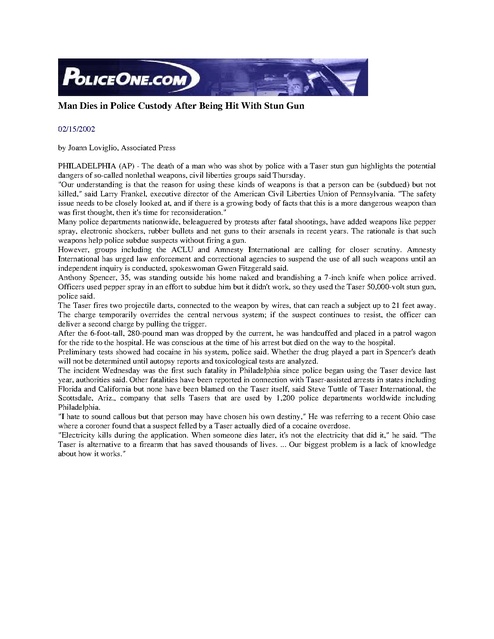Taser Philadelphia Taser Death Ap Story 2002
Download original document:

Document text

Document text
This text is machine-read, and may contain errors. Check the original document to verify accuracy.
Man Dies in Police Custody After Being Hit With Stun Gun 02/15/2002 by Joann Loviglio, Associated Press PHILADELPHIA (AP) - The death of a man who was shot by police with a Taser stun gun highlights the potential dangers of so-called nonlethal weapons, civil liberties groups said Thursday. "Our understanding is that the reason for using these kinds of weapons is that a person can be (subdued) but not killed," said Larry Frankel, executive director of the American Civil Liberties Union of Pennsylvania. "The safety issue needs to be closely looked at, and if there is a growing body of facts that this is a more dangerous weapon than was first thought, then it's time for reconsideration." Many police departments nationwide, beleaguered by protests after fatal shootings, have added weapons like pepper spray, electronic shockers, rubber bullets and net guns to their arsenals in recent years. The rationale is that such weapons help police subdue suspects without firing a gun. However, groups including the ACLU and Amnesty International are calling for closer scrutiny. Amnesty International has urged law enforcement and correctional agencies to suspend the use of all such weapons until an independent inquiry is conducted, spokeswoman Gwen Fitzgerald said. Anthony Spencer, 35, was standing outside his home naked and brandishing a 7-inch knife when police arrived. Officers used pepper spray in an effort to subdue him but it didn't work, so they used the Taser 50,000-volt stun gun, police said. The Taser fires two projectile darts, connected to the weapon by wires, that can reach a subject up to 21 feet away. The charge temporarily overrides the central nervous system; if the suspect continues to resist, the officer can deliver a second charge by pulling the trigger. After the 6-foot-tall, 280-pound man was dropped by the current, he was handcuffed and placed in a patrol wagon for the ride to the hospital. He was conscious at the time of his arrest but died on the way to the hospital. Preliminary tests showed had cocaine in his system, police said. Whether the drug played a part in Spencer's death will not be determined until autopsy reports and toxicological tests are analyzed. The incident Wednesday was the first such fatality in Philadelphia since police began using the Taser device last year, authorities said. Other fatalities have been reported in connection with Taser-assisted arrests in states including Florida and California but none have been blamed on the Taser itself, said Steve Tuttle of Taser International, the Scottsdale, Ariz., company that sells Tasers that are used by 1,200 police departments worldwide including Philadelphia. "I hate to sound callous but that person may have chosen his own destiny," He was referring to a recent Ohio case where a coroner found that a suspect felled by a Taser actually died of a cocaine overdose. "Electricity kills during the application. When someone dies later, it's not the electricity that did it," he said. "The Taser is alternative to a firearm that has saved thousands of lives. ... Our biggest problem is a lack of knowledge about how it works."





